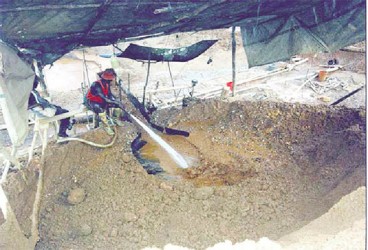Gold declarations for 2014 dropped by almost 20% compared to the previous year, ending at 387,508 ounces as against 481,087 ounces declared for 2013 and miners say that more of the fiscal benefits enjoyed by large-scale licencees should be extended to smaller operators to ensure the health of the sector.
“It is the view of the GGDMA that key mining policy changes are needed to allocate more of the fiscal benefits currently enjoyed by large scale licencees to small and medium scale producers as well. These strategic changes need to be made immediately to close the gap between the generous fiscal incentives awarded to large scale licencees and the limited incentives allowed for Guyana’s small and medium scale producers,” the Guyana Gold and Diamond Miners Association (GGDMA) said in a statement.
“Without those benefits local gold production would continue to decrease and the large scale licencees would be unable to make up the slack,” it added. The GGDMA said that it is aware that short-term strategic change to the fiscal regime for mining is not new to Guyana since large scale bauxite operations currently benefit from substantially reduced or no royalty on the production of bauxite.

“The strong local capital investment in the gold mining sector must not be disrespected any longer. The powerful multiplier effect of the local gold mining industry must not be hidden any longer. The right of the small miners to work in their chosen profession must be safeguarded. The opportunity for poverty alleviation through work in the local mining sector must be defended,” it asserted.
The miners’ body called on the authorities to recognize that “the aggregate contribution of Guyana’s local gold sector is by far greater than the projected contribution of large scale operations and their foreign direct investments.” They reiterated that government must improve the fiscal incentives for small and medium scale producers so that their contribution would not be strangled.
Describing the 2014 production, which is 19.5% lower than 2013, as “heroic,” the GGDMA said that in the face of extreme pressure caused by the low price of gold and with only limited support from the government once again, the aggregate gold production by solely local small and medium scale gold miners is greater than the projected combined production from imminent operations of large scale licencees Guyana Goldfields Inc’s Aurora Gold Project and Troy Resources Guyana Inc.
The gold industry achieved total declarations of 481,087 ounces in 2013, representing the highest level of production in the history of the industry but this dropped last year. For the past few years, gold has been a mainstay of Guyana’s economy. In 2009, gold declarations were 305,178 ounces, while in 2010 declarations rose to 308,438 ounces. In 2011 gold declarations were just about 363,083 ounces, while in 2012, this increased to 438,645 ounces.
Last year, some miners, confronted with a variety of factors, exited the sector. The Guyana Gold Board (GGB) last month had said that gold purchased by the GGB had fallen by 41.24% and revenue to the board declined by 43.48%.
The GGDMA was undertaking a study to determine why declarations had dropped and when contacted, Colin Sparman, administrative coordinator of the GGDMA said that this is yet to be completed and some more fieldwork in the various mining districts is required.
He said that their preliminary findings point to lower production due to scaling down of many operations due to relatively high operating costs against relatively low gold prices; many operators were re-working old work-grounds which could be economic at low yield and high gold price that became uneconomic at low yield and low gold price; and the unavailability of gold bearing lands to miners although there were lotteries and auctions during 2014. He explained that some of these lands are inaccessible meaning transportation costs to get there are prohibitive.
Further, Sparman added that a fair number of Brazilians left the industry subsequent to Operation El Dorado which found several undocumented Brazilian miners working unlawfully. Most left for Suriname where the legal process offers less hassle, he said.
The GGDMA official said that the miners have not yet set a target for production this year and said that their outlook was optimistic but pragmatic. “At current gold prices most operators can remain in business with lower profits. There are no comparable alternatives,” he said.
According to Sparman, they do not see gold price rising but believe that it would remain steady at around US$1,200 to US$1,300 per ounce. In terms of the people entering or leaving the sector, Sparman said that there is a critical mass of miners who stay in the industry no matter what. “At very high gold prices a number of persons entered the industry and who operated at the margins. When conditions changed marginally, they left,” he added.




